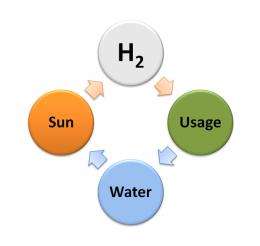May 24, 2012 report
HyperSolar shows dirty water no barrier to power world

(Phys.org) -- The Santa Barbara, California, company, HyperSolar, is set to transparently share the ups and downs of its research experiences toward the company’s ultimate vision, successfully producing renewable hydrogen. The company is setting down experiences with their own development processes. The company this week reported an achievement, in that it was able to announce that its first proof of concept prototype is successfully producing renewable hydrogen.
The company is focused on working out less costly, sustainable and environmentally friendly methods for producing hydrogen gas; their research involves producing hydrogen gas in a zero-carbon process from wastewater.
The technology involves a low-cost polymer coating with a small-scale solar device to form a self-contained particle that separates hydrogen from water using the power of the sun.
In a video demo, one can view the company’s own “artificial photosynthesis process” in that the approach mimics photosynthesis to split water molecules into hydrogen gas.
Tim Young, CEO of HyperSolar, described the test. An inexpensive plastic baggy was filled with wastewater from a mill and on the bottom of the baggy was a small-scale solar device protected with HyperSolar’s polymer coating. Bubbles coming up are free hydrogen using the power of the sun.
Most hydrogen used today is not renewable and not clean, coming from hydrocarbon sources, such as oil, coal and natural gas. Renewable hydrogen in contrast is produced from nearly infinite sources of water and sunlight, is clean and carbon-free.
The electrolysis goal of the company is nothing new; splitting water molecules into hydrogen and oxygen using electrolysis has been well known. In theory, this would be the way for a greener world. Commercial electrolysis, counters Young, has so far offered up expensive and impractical methods, however.
The requirement for highly purified clean water to prevent fouling system components amounts to an inability to make use of the large quantities of free water from oceans, rivers, industrial waste and municipal waste as feedstock. HyperSolar's technology is designed to use any natural water or waste water for renewable hydrogen.
Young has confidence that his process can achieve commercial viability as a result. “Starting with a negative value feedstock in the form of wastewater and operating in low cost reactors, we believe that our artificial photosynthesis process of extracting hydrogen from water will be cost effective,” he said. Moving forward, Young suggests the solar device used in the prototype will be replaced with HyperSolar’s nanoparticles, which can be mass-produced and lead to large-scale production of hydrogen gas.
The impact of renewable hydrogen to generate electricity and to power fuel cell vehicles, for Young, would be nothing short of extraordinary. According to Young, “If we can successfully complete the development of a low-cost, highly efficient solar powered water-splitting nanoparticle, we can use readily available seawater, runoff water, river water, or wastewater, to produce large quantities of hydrogen fuel to power the world.”
HyperSolar recently entered into a yearlong sponsored research agreement with the University of California, Santa Barbara.
More information: Press release
© 2012 Phys.Org


















